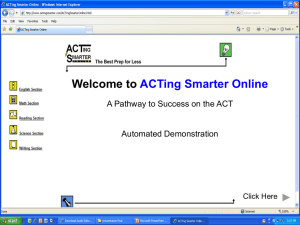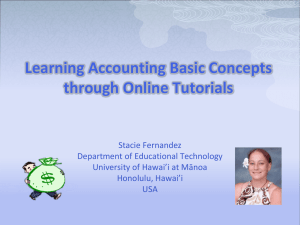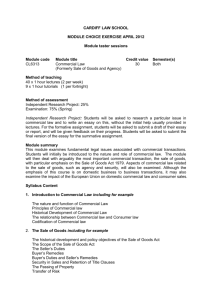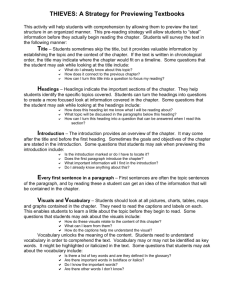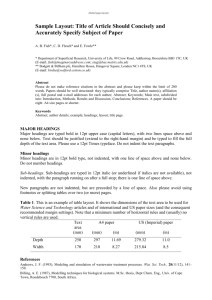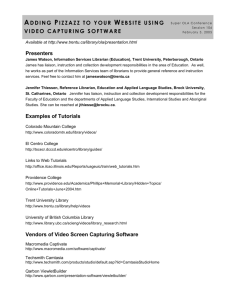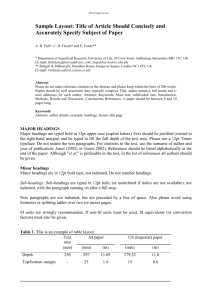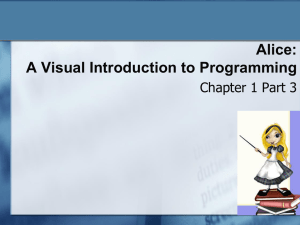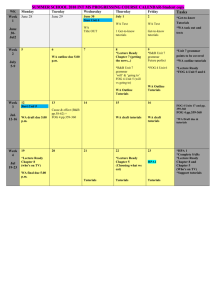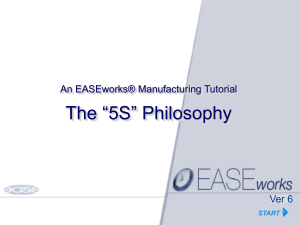HCI Tutorials: Natural Language, Interface Design, Evaluation
advertisement
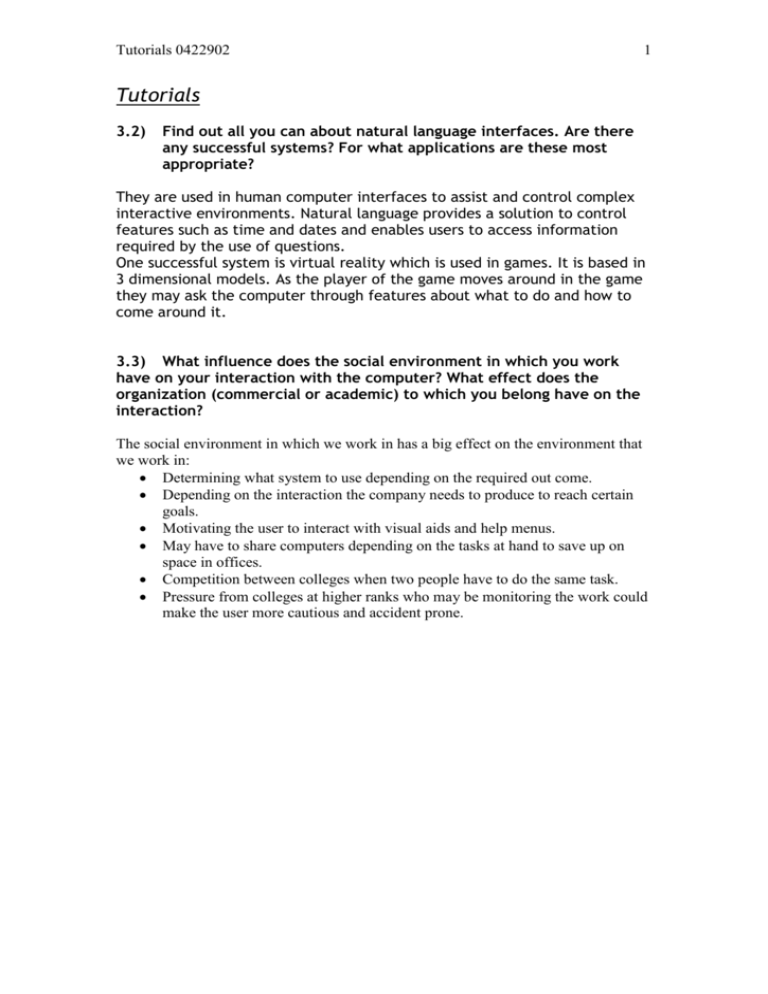
Tutorials 0422902 1 Tutorials 3.2) Find out all you can about natural language interfaces. Are there any successful systems? For what applications are these most appropriate? They are used in human computer interfaces to assist and control complex interactive environments. Natural language provides a solution to control features such as time and dates and enables users to access information required by the use of questions. One successful system is virtual reality which is used in games. It is based in 3 dimensional models. As the player of the game moves around in the game they may ask the computer through features about what to do and how to come around it. 3.3) What influence does the social environment in which you work have on your interaction with the computer? What effect does the organization (commercial or academic) to which you belong have on the interaction? The social environment in which we work in has a big effect on the environment that we work in: Determining what system to use depending on the required out come. Depending on the interaction the company needs to produce to reach certain goals. Motivating the user to interact with visual aids and help menus. May have to share computers depending on the tasks at hand to save up on space in offices. Competition between colleges when two people have to do the same task. Pressure from colleges at higher ranks who may be monitoring the work could make the user more cautious and accident prone. Tutorials 0422902 2 3.4a) Group the following functions under appropriate headings, assuming that they are to form the basis for a menu-driven wordprocessing system - the headings you choose will become the menu titles, with the functions appearing under the appropriate one. You can choose as many or as few menu headings as you wish. You may also alter the wordings of the functions slightly if you wish. File- Save, Save as, New, Quit, Open file, Close, copy file. Edit- Delete, Undo, Cut, Paste, Copy, Clear, Repaginate, Edit, Repeat. View- print, print preview, page setup, view page, view index, see table of contents, show alternative document Insert- add footnote, add page break, insert graphic, insert index entry Format- Glossary, preferences, character style, format paragraph, layout document, position on page, plain text, bold text, italic text, change font, decrease point size, increase point size. Tools- Find words, Change word, go to, go back, and check spelling, word count, renumber pages Table- Table Help- Help Mail- Open and send mail. 3.4b) If possible, show someone else your headings, and ask them to group the functions under your headings. Compare their groupings with yours. You should find that there are areas of great similarity, and some differences. Discuss the similarities and discrepancies. Why do some functions always seem to be grouped together? As they may be related in one way or another. They may be commonly used together and easy to find. Why do some groups of functions always get categorised correctly? Easy to find out what a function does. Why are some less easy to place under the 'correct' heading? Their may be no relation to a heading or may belong to more then one heading. Why is this important? For users to easily find and use. Tutorials 0422902 3 Design Basics 5.3) Comment on the use of layout and other elements in the control panels (figures CS.1, CS.2 and CS.3), including the way in which various visual elements support or hinder logical grouping and sequence. CS 1. The layout is all cramped into little space and hard to read. The colour is only used in certain parts of the diagram. Extra information then needed. CS.2. Basic controls in the layout with the functions grouped together. The colour is used more effectively. CS 3. Not enough colours used. Used for data input and reading. The data is grouped together on relationships. Tutorials 0422902 4 Design Rules 7.1) What was the problem with the synthesis example comparing a command language interface with a visual interface? Can you suggest a fix to make a visual interface really immediately honest? The problem is that a visual interface would not provide the user with any information on weather or not a file has been saved or not. In command line interface the only way a user would be able to find out if it is saved is to go to the destination folder to confirm it is there. A way to resolve this matter would be to show the destination folder once the user has saved the file. This would show confirmation that the file is stored correctly. (7.3) It has been suggested in this chapter that consistency could be considered a major category of interactive principles, on the same level as learnability, flexibility and robustness. If this had been the case, which principles discussed in this chapter would appear in support of consistency? Affordance- a button should always be able to be pushed Predictability- the system should respond to how the user would expect it to be from previous experience from related websites. Response time stability- the system should respond with similar times and actions depending on its usage. Familiarity- should relate to previous real world experience by users. Tutorials 0422902 5 9.2) what are the benefits and problems of using video in experimentation? If you have access to a video recorder, attempt to transcribe a piece of action and conversation (it does not have to be an experiment - a soap opera will do!). What problems did you encounter? The advantages would e that it would be accurate and the recordings would be in real time. You would be able to see it over and over again. How ever it would pick up every little mistake which would be a problem when live recording. It needs a lot of special equipment and takes up loads of images to process and store which can clog systems. You might have to record in more then one angle for certain parts of the recordings. It would cost a lot of money and time. You can print out still pictures from the video which can be an advantage if needed. 9.4) Choose an appropriate evaluation method for each of the following situations. In each case identify (i) The participants. (ii) The technique used. (iii) Representative tasks to be examined. (iv) Measurements that would be appropriate. (v) An outline plan for carrying out the evaluation. (a) You are at an early stage in the design of a spreadsheet package and you wish to test what type of icons will be easiest to learn. (b) You have a prototype for a theatre booking system to be used by potential theatre-goers to reduce queues at the box office. (c) You have designed and implemented a new game system and want to evaluate it before release. (d) You have developed a group decision support system for a solicitor's office. (e) You have been asked to develop a system to store and manage student exam results and would like to test two different designs prior to implementation or prototyping. Situation Spreadsheet Participants Academics Secretaries Students Accountants General users Technique Feedback Representative tasks Sorting data Printing Formatting cells Adding functions Producing graphs Appropriate measurements Ease of use accurate and fast Outline plan Test icons individually and each formulae Tutorials 0422902 6 Theatre General public Theatre-goers Previous customers Ask individuals Tickets for show changing seats, booking, ticket and priority Ease of use Easy to understand Speed Error correction Record observation while prototype is running New game Developers Game players Easy to use and fault free Progression, speed and achievements Finish game and then evaluate aspects of it Solicitors Solicitors Clients Reviews and opinions of people involved Trial and error Decision making Complex issues Legal matters Accuracy Accessibility Fault free Ease of use Error correction Use it to perform day to day tasks. Student exams Examiners tutors Testing Debate Questionnaires Editing and storing marks as well as security Ease of use High security and error free storage Test program while old one is still in use
